Dealing With Sore or Tender Nipples While Breastfeeding
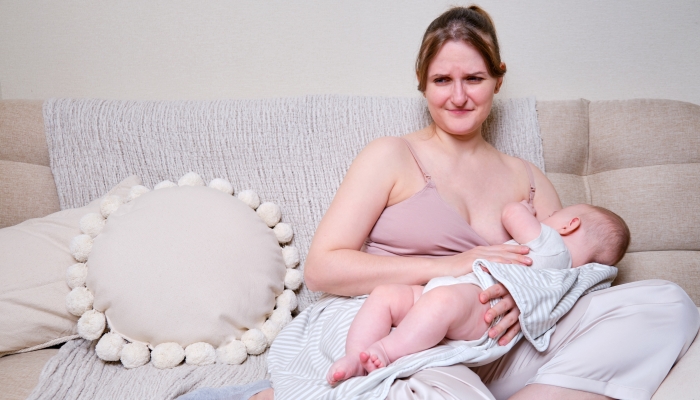
- Nipple and breast soreness often present themselves in the first days of breastfeeding.
- If you have a red, hot lump on your breast, nipple discharge, a burning sensation in your nipple, or flu-like symptoms, contact your doctor.
- An improper latch can cause nipple chafing, blisters, cracks, and bleeding.
When my husband and I brought our first child into the world, I couldn’t wait to experience all the beautiful moments of motherhood. I couldn’t wait to give our baby her first bath. I couldn’t wait to breastfeed and experience the joy of—ouch!
What I thought would be a beautiful moment of joy turned out to be a painful process. Breastfeeding was not an easy task. My sore nipples made every breastfeeding session feel like torture.
Thankfully, I was able to get in touch with a few breastfeeding experts. Through trial and error, I found several ways to soothe my sore nipples so I could continue breastfeeding.
Nipple and breast pain during breastfeeding is common. Many moms have had to endure the hardship of nursing through nipple tenderness. Talk to any breastfeeding warrior and she’ll likely tell you it’s just part of the process.
However, this doesn’t mean that it’s always normal. It also doesn’t mean that you have to suffer through it. Here’s the full scoop on sore or tender nipples while breastfeeding.
Tender Nipples While Breastfeeding: Is It Normal?
Breastfeeding takes a toll on your body. It’s not uncommon for moms to experience nipple pain while breastfeeding, but is it normal? Yes and no.
Nipple pain that only lasts during the early days of breastfeeding is normal.
Nipple and breast soreness often present themselves in the first few days of breastfeeding. This is due to your breast tissue expanding to accommodate the milk and your nipples adjusting to the suction. The adjustment period usually lasts 5–7 days.
Nipple pain that continues past 7 days might be a sign of abnormal nipple soreness. You should check with a lactation consultant or your doctor to be evaluated further.
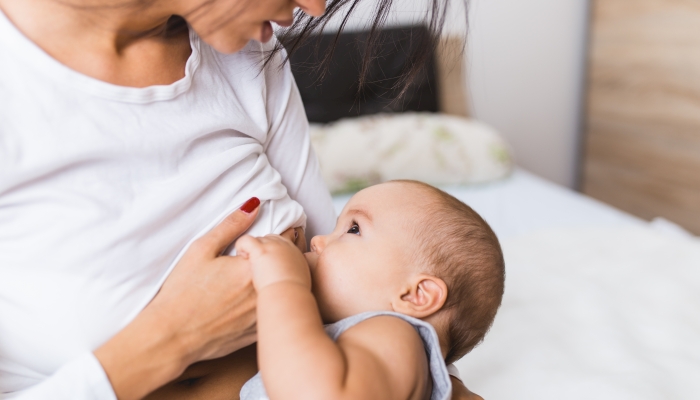
What Causes Nipple Pain When Breastfeeding?
We know that the frequent suction on your breasts can cause nipple soreness, but what else might contribute to it? There are several potential causes of nipple pain during breastfeeding. These include:
Improper Latch
An improper latch means your baby isn’t sucking on the correct portion of your nipple. A shallow latch and lipstick nipple latch are common issues with breastfeeding that cause pain. An improper latch can cause nipple chafing, blisters, cracks, and bleeding.
Tongue Tie
When your baby is in the womb, there is a small band of skin underneath their tongue attaching the tongue to the bottom of the mouth. This band is supposed to recede completely by birth. When it remains, the baby is born with a tongue tie.
Tongue ties are often thick and strong, limiting your baby’s ability to nurse properly. You can check for a tongue tie by gently feeling under your baby’s tongue. If you find one, discuss your options for treatment with a pediatric dentist.
Inverted or Flat Nipples
When your nipples don’t extend outward, it can make it difficult for your baby to get a proper latch. Examine your nipples before a breastfeeding session to determine if this might be the cause. Manual stimulation is one way to encourage your nipples to pull forward.
Improper Removal From Breast
When your baby is finished feeding they will often open their mouth and pull away from the breast. If you try pulling your baby away while nursing, you will likely make your nipples hurt worse. To properly unlatch, place the tip of your finger in the side of your baby’s mouth to break the suction before unlatching.
Fragrances or Chemicals in Soaps
Harsh chemicals or fragrances in bath soaps or laundry detergents can cause nipple and breast tenderness. Sensitive nipples might become dry or cracked. Use fragrance-free and chemical-free soaps to avoid an allergic reaction or dryness.
Tight Bra
A poorly fitting bra will put pressure on your breasts and nipples. It might also rub against sore nipples, making the pain worse. A light, cotton sports bra might be a better option to relieve the pressure and pain.
Mastitis
If you’ve ever had mastitis, you know how much pain it can cause. Mastitis is an infection in the breasts caused by a clogged milk duct. Breast pain caused by mastitis is excruciating and often requires pain relievers and antibiotics for treatment.
If you have a red, hot lump on your breast, nipple discharge, a burning sensation in your nipple, or flu-like symptoms, contact your doctor. Some women have found success using cabbage leaves for mastitis to manage pain.
Thrush
Thrush is a yeast infection that can occur in your mouth and other parts of your body. It’s common after using antibiotics or when you have cracked nipples. You might notice white, patchy spots in your baby’s mouth and nipple pain after each feeding.
Contact your doctor if you suspect thrush to be a cause of your sore breasts and nipples.
Vasospasm
A vasospasm is characterized by a sharp pain in your breasts lasting a few seconds. This is caused when the blood vessels spasm and restrict blood flow in your breast. Avoiding cold air may help, but you should talk to your doctor for more options.
What are the most common reasons for sore nipples during breastfeeding?
According to a 2015 study published in the International Journal of Environmental Research and Public Health, conducted by Jacqueline C. Kent, Elizabeth Ashton, et al., and titled Nipple Pain in Breastfeeding Mothers: Incidence, Causes and Treatments, persistent nipple pain is the number one reason mothers stop breastfeeding exclusively.
They also note that “The most common attributed cause of nipple pain was incorrect positioning and attachment, followed by tongue tie, infection, palatal anomaly, flat or inverted nipples, mastitis, and vasospasm.”
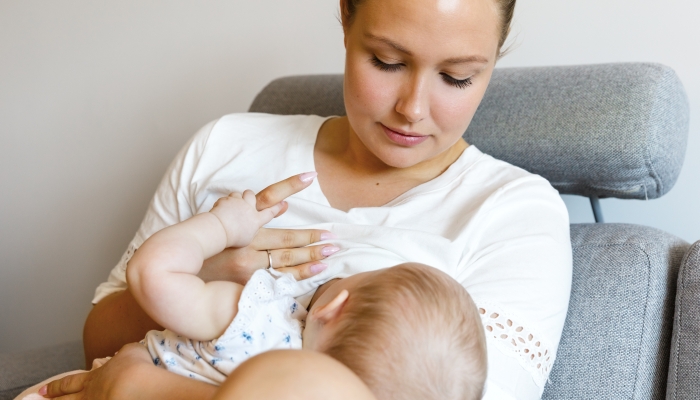
Should You Continue Breastfeeding if Your Nipples Are Hurting?
Despite the nipple pain you may be feeling, it’s important to persist through the early days of breastfeeding. Breastmilk is very beneficial for babies, and the pain usually resolved quickly.
This crucial stage of motherhood is often when mothers get the most discouraged. A strong support group and a plan will give you a greater chance at successful breastfeeding. You might also consider hiring a lactation consultant to provide further advice and support.
Tips on How to Soothe Tender Nipples From Breastfeeding
To soothe and treat sore nipples from breastfeeding, you can try several remedies. Many moms have found success from the following options:
Proper Position
A proper position during breastfeeding can make a huge difference in nipple and breast pain. You should place your baby in a position that encourages a proper latch. Some of the best positions for breastfeeding include:
- Cradle hold
- Cross cradle hold
- Lying back
- Side-lying
- Football hold
You can also help you baby achieve a proper latch by holding your breast and inserting your nipple into their mouth when it’s wide open. Aim to get the majority of your areola in their mouth.
Breast Milk
As odd as it may sound, breast milk can soothe nipple pain caused by breastfeeding. To try this method, express a few drops of milk from your nipples and rub it around the area. Allow your nipples to dry before putting your bra back on.
Ointment
Using a nipple cream for breastfeeding can soothe nipple irritation from breastfeeding or using a breast pump. Some moms choose to avoid nipple creams containing lanolin, as this can cause allergic reactions. An olive or coconut oil-based cream is a safe choice.
Warm Compress
Using a warm compress for breast pain can decrease nipple pain as well as help with engorgement. Run a washcloth in warm to hot water, place over the breast, and repeat as necessary. You can also purchase a heating pad for breastfeeding which might be more convenient.
Nipple Guards
Nipple guards are small latex covers that go over your nipple during breastfeeding. These are one of my go-to choices for resolving nipple pain. The cover relieves your nipple of the pressure from sucking but still allows your child to feed.
When To Consult Your Doctor
There are times when sore nipples are a sign of something more serious. In rare sore nipples could be an indicator of breast cancer, an infection in your milk ducts, or other issues. If you experience any of the following symptoms, contact your doctor:
- Flu-like symptoms
- Abnormal nipple discharge
- Painful, swollen lump in the breast
- Persistent pain that doesn’t decrease past the first week of breastfeeding
FAQs
How long does it normally take for nipples to get used to breastfeeding?
Most moms will experience pain for the first week. The pain usually peaks around days 3–5. You should start to feel the pain lessen after this point.
You might also experience pain from your uterine contracting while breastfeeding during this same time period. When you add in hormonal changes and sleepless nights, it can feel overwhelming. This is the perfect time to contact a lactation consultant who can come alongside you and provide the support you need.
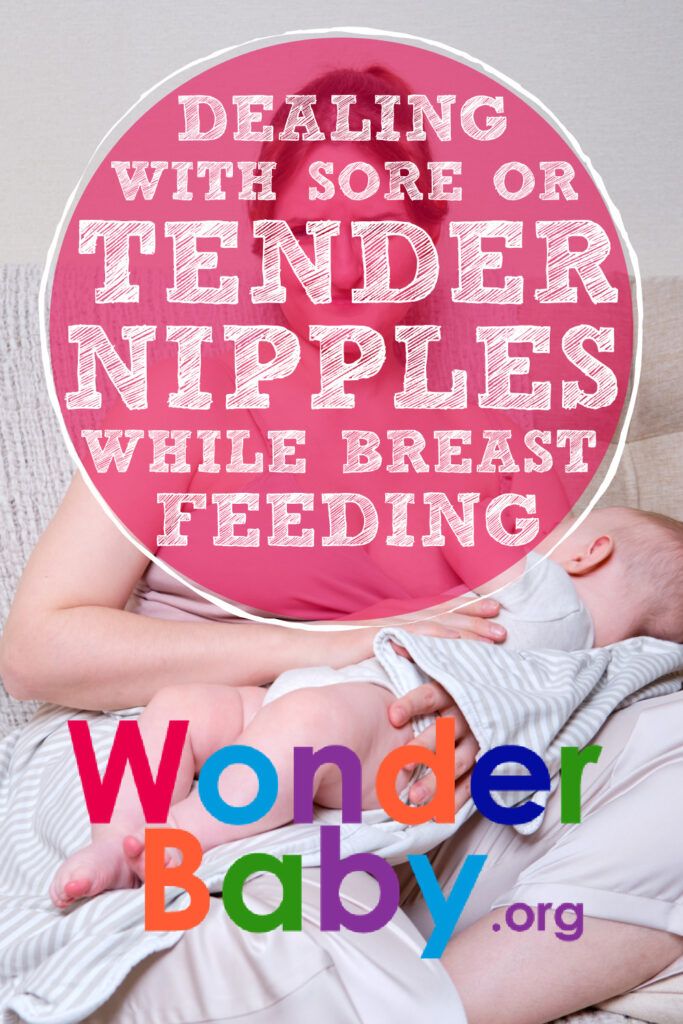
Related Posts
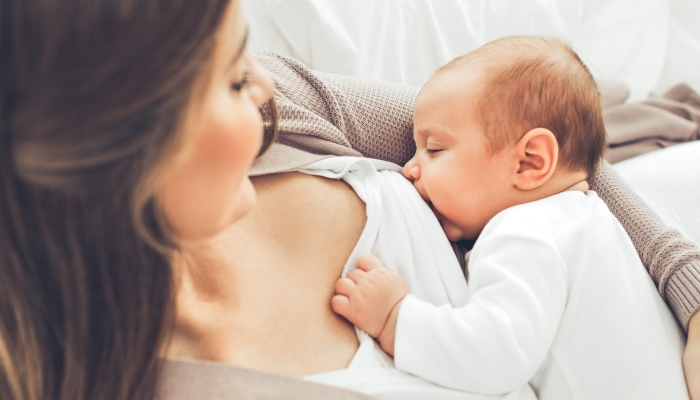
Breastfeeding, Sleep
Sleep and Breastfeeding: A Comprehensive Guide for Nursing Moms
Many people assume breastfeeding and sleep training don’t go together, but it is possible to help your baby sleep better while continuing your breastfeeding journey.
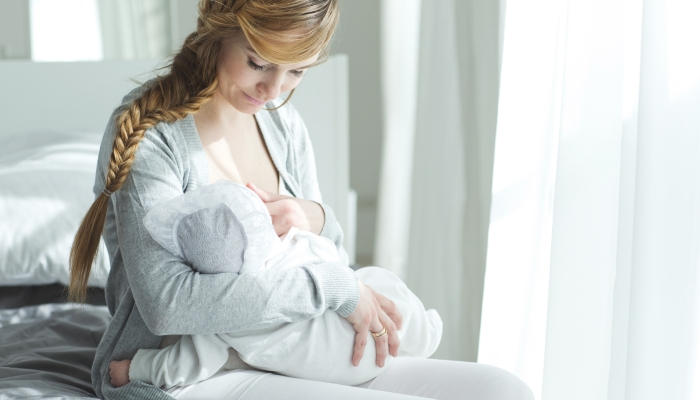
Breastfeeding
Comfort Nursing: Pros, Cons, and How to Stop
Find out what comfort nursing is, when should you worry about it, and how to stop or limit your baby's comfort nursing (especially at night!).
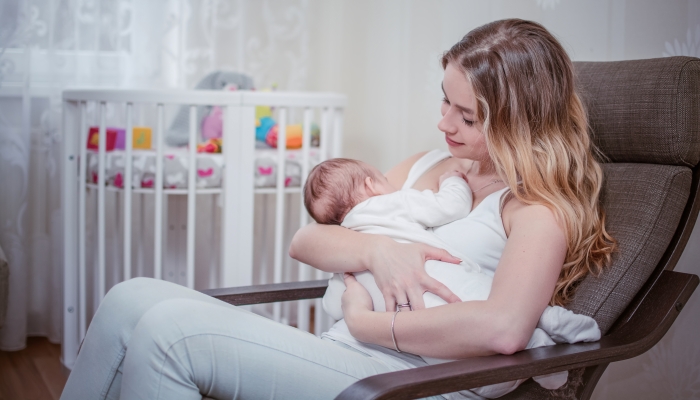
Breastfeeding, Product Reviews
5 Best Breastfeeding Chairs for Nursing Moms of 2023
Whether you want a gentle rock, a smooth glide, or a cozy cuddle to soothe your baby to sleep, you’ll have your pick of the best breastfeeding chairs on the...